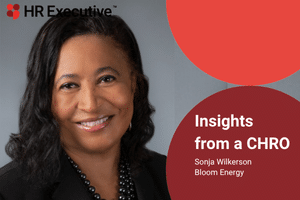AI integration is a top-of-mind opportunity—and simultaneously, a challenge—for most HR leaders today.
At Bloom Energy—whose proprietary Energy Server uses solid oxide fuel cell technology to generate clean electricity without combustion, powering AI data centers and commercial and industrial clients—AI integration into HR and other processes is a natural evolution, says Sonja Wilkerson, chief people officer.
“How we’re leveraging AI internally and in the HR space ties back to our core business—providing energy to data centers—which is booming as a result of AI demand,” Wilkerson says.
Yet, she cautions, the function at the 2,000-person organization is moving strategically toward AI integration across the organization—being guided by business goals and a people-centric culture, rather than trends.
“We’re like others: We’re learning that we need to take a pragmatic, systematic approach to integrate AI enterprise-wide,” she says.
Wilkerson—who joined Bloom Energy in 2019 after HR leadership roles at organizations including Infinera, Hewlett Packard Enterprise and Cisco—spoke recently to HR Executive about the philosophy guiding Bloom Energy’s AI integration work and how the organization is prioritizing flexibility and inclusion in its talent strategies.
HR Executive: Where’s your HR focus right now?
Wilkerson: We’re leveraging AI in HR but are still currently in the beginning stages. Specifically, we’ve been using AI in the recruiting space to source candidates, though we are in the testing phase to best understand how it works and what the outcomes are.
We’re also leveraging AI to consolidate employee feedback. For example, when we do our employee engagement surveys, it takes thousands of different comments and highlights key trends in ways that we could not have done previously.
HR Executive: How are you navigating the pressure many CHROs are facing around AI integration in HR?
Wilkerson: I’ve never been one to go along with the trend because it’s a trend. I’ve always approached this work from [the perspective of] what results are we driving for? In our world of Bloom, we have to scale and recognize the benefits that AI can bring. But we’re not bringing AI into every aspect of HR.
We’re taking a very pragmatic approach to staffing and sourcing. We can see the outcome, analyze the results of investing in AI and then decide where we go. But I’m not going to accelerate the adoption of technology that can have a negative impact on the organization due to pressure or trends. I would say you have to recognize the opportunity to leverage something that can bring benefits. So, it requires balance.
See also: To maximize AI training, build ‘habits, not checklists’
HR Executive: What role is the build/buy/borrow/bot conversation having in Bloom’s talent strategy?
Wilkerson: Bloom was founded 24 years ago, so I guess we’re a teenager, in this case. This organization has grown organically over the years because of the uniqueness of our technology. We are a unique blend of technology, engineering and purpose-driven innovation—where brilliant minds and experienced operators work side by side to solve the world’s toughest energy challenges.
As this company has grown, it’s been more of a build. We are continuing to scale, and there will be certain aspects of the work that we will benefit from bringing in experts to do it differently. As you continue to automate, you have to bring in automation experts that advance that work. I do believe, though, that we’ll continue to build. We haven’t made an acquisition, and our turnover is minimal.
HR Executive: As you’re building, what is driving your talent strategy?
Wilkerson: Our strategy continues to evolve. We have a very comprehensive talent development strategy—from a goal-setting process through check-ins, all the way through our performance management system, which we call a contribution assessment. We felt it was super important to assess our employees on contribution, in terms of what they’re delivering and bringing to the organization.
We’re also continuing to design our organization in a way that reduces the talent gaps and skills gaps going forward, as well as giving our employees an opportunity to move as their roles bifurcate from generalists to specialists.
HR Executive: How did the pandemic influence the direction of the talent strategy?
Wilkerson: We’re a manufacturer: Forty-five percent of our employees are in manufacturing, so they didn’t have the luxury of assembling our product from home. Now, we have a work-in-the-office culture because we want to create a fair and equitable workforce. We found that when individuals are together, co-located, our ability to move faster, to address issues quicker, to catch each other in real time, improved.
We do have a flexible environment. If people need to go pick up their dog at the vet, or go to their kids’ play, they can. People get to manage their lives, and that’s how we’ve balanced it out.
HR Executive: How has Bloom made the most meaningful strides for advancing underrepresented groups in your sector, particularly women?
Wilkerson: I’m super proud of this. When people were making decisions [about DEI], they would say, “Sonja, what statement are you going to make?” And I said, “I don’t need to make a statement.” Here’s why: We’ve always hired the most qualified people. We’ve never compromised. We have an inclusive culture that has led to amazing diversity. This company is the most diverse company I have ever worked for. We’re super proud of the diversity we’ve been able to attract to the organization.
Diversity leads to diversity. If you look at our executive leadership teams, we have four women at the top, women of color, culturally diverse leaders and a CEO of Asian descent. Diversity is just a part of our DNA. If diversity is part of your DNA and core value system, it naturally influences how you treat people and shapes an inclusive environment that starts at the top. That way, you have a higher chance of attracting and retaining diverse talent.



